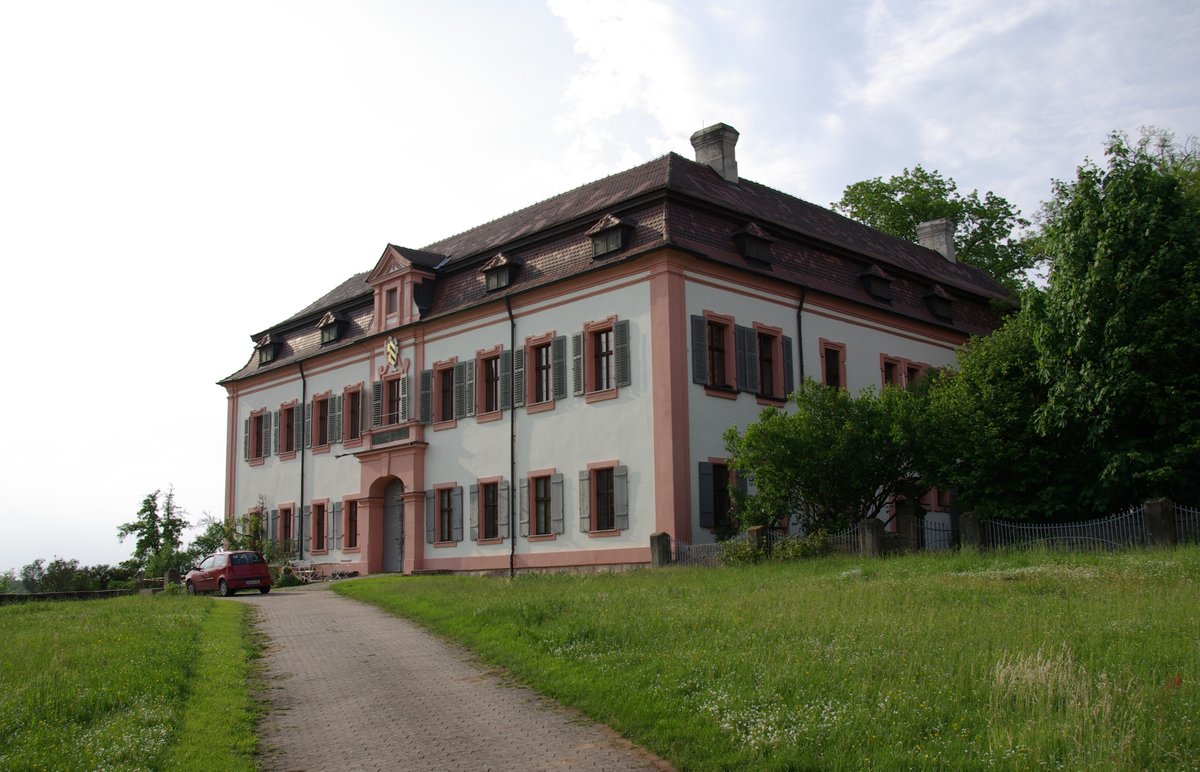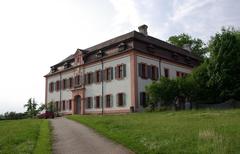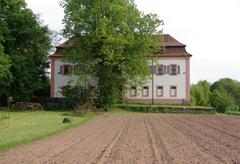
Schloss Großgründlach: Visiting Hours, Tickets, and In-Depth Guide to Nuremberg’s Historic Baroque Castle
Date: 14/06/2025
Introduction: Schloss Großgründlach and Its Historical Significance
Situated on the northern edge of Nuremberg, Schloss Großgründlach is one of Franconia’s most fascinating historical landmarks. Spanning over a millennium of history, the castle embodies the evolution of the region—from its roots as a medieval fortress and religious center to its transformation into an elegant Baroque residence. Today, it stands as a testament to Nuremberg’s dynastic, religious, and cultural shifts, and continues to serve as a vibrant hub for community events and heritage celebrations.
Whether you are passionate about history, architecture, or simply seeking a tranquil retreat from the city center, Schloss Großgründlach offers a rich experience. This guide provides a comprehensive overview of its history, architectural highlights, practical visitor information, and tips for making the most of your trip. For the latest updates and event listings, consult the official Schloss Großgründlach website or the Alt-Gründlach Association.
Contents
- Discover Schloss Großgründlach: History & Highlights
- Early Origins and Medieval Foundations
- Dynastic Changes and Religious Transformation
- Renaissance and Baroque Rebuilding
- Notable Figures and Families
- Architectural Features and Cultural Value
- Visiting Schloss Großgründlach: Hours, Tickets, and Accessibility
- Events, Activities, and Nearby Attractions
- Tips for Visitors
- Frequently Asked Questions (FAQ)
- Plan Your Visit and Additional Resources
Discover Schloss Großgründlach: History & Highlights
Schloss Großgründlach is renowned as Nuremberg’s oldest recorded district, first mentioned in a 1021 imperial deed. Over the centuries, the castle has evolved from a medieval stronghold established by the von Gründlach family into a Cistercian convent, and later into an aristocratic Baroque manor. Its four-winged Baroque complex, ornate interiors, and scenic gardens make it a unique destination for both history enthusiasts and cultural travelers.
Early Origins and Medieval Foundations
The earliest reference to Großgründlach is found in a 1021 deed by Emperor Henry II, which notes the area as “Villa Crintilaha” and documents its donation to Bamberg Cathedral. By the 13th century, the von Gründlach family constructed a fortified residence that controlled significant territories along the Regnitz and Schwabach rivers, cementing the castle’s role as a regional power center (stadtmedien.com).
Following the extinction of the Gründlach male line in the early 14th century, the estate passed through several hands, reflecting the fluid political landscape of the era.
Dynastic Changes and Religious Transformation
- Margarete von Gründlach, heiress of the family, married Count Gottfried von Hohenlohe-Brauneck. The property was then sold to Burgrave Frederick IV of Nuremberg.
- In 1343, Kunigunde von Orlamünde acquired the castle and established the Cistercian convent Himmelthron, transforming the fortress into a monastic complex. The nuns relocated here in 1348, adapting both the castle and church for spiritual use (herrensitze.com).
The convent flourished until the Reformation of 1525, when it was dissolved, and the castle came under the administration of the Imperial City of Nuremberg.
Renaissance and Baroque Rebuilding
Schloss Großgründlach suffered extensive damage during the Second Margrave War in 1552 and the Thirty Years’ War in 1634. Restoration began in 1572 under Philipp Geuder, a prominent Nuremberg patrician, who rebuilt the castle within its medieval walls. The most dramatic transformation occurred in the late 17th century when the property was redesigned as a Baroque residence by architect Johann Trost.
Key Baroque features include:
- Four-winged layout with a central courtyard
- Ornate stuccoed interiors, including the Theatersaal (theatre hall)
- Baroque gardens and a grand avenue planted in 1769, offering sightlines to the Gründlach river
Ownership eventually passed to the Haller von Hallerstein family in the mid-18th century, who enhanced the estate’s artistic and architectural significance (nuernberg-direkt.com).
Notable Figures and Families
- Margarete von Gründlach: Instrumental in the estate’s transition to the Hohenlohe-Brauneck line.
- Kunigunde von Orlamünde: Founder of the convent and key figure in the site’s religious history.
- Philipp Geuder: Led the Renaissance-era reconstruction after war damage.
- Haller von Hallerstein family: Oversaw the Baroque transformation and have managed the estate since the 18th century.
Architectural Features and Cultural Value
Schloss Großgründlach is a prime example of Franconian castle architecture, blending medieval remnants with Baroque grandeur:
- Baroque Four-Wing Plan: The symmetrical layout encloses a central courtyard, while the south façade features nine axes and a central projection crowned by a dormer.
- Historic Gardens and Avenue: The Baroque garden and linden-lined avenue remain integral to the estate’s landscape design.
- Medieval Cellars and Curtain Walls: Early structures and masonry are still visible, including sections of the original parish church and castle chapel (stadtmedien.com).
- Cultural Legacy: The castle’s Theatersaal, with its alliance coats of arms and Latin inscriptions, reflects the Enlightenment and Baroque ambitions of its owners.
Adjacent to the castle, St. Laurentius Church showcases baroque architecture and medieval stained glass, forming part of a picturesque village ensemble.
Visiting Schloss Großgründlach: Hours, Tickets, and Accessibility
Opening Hours
- Castle Gardens & Grounds: Open during special public events or by prior arrangement.
- Wächterhaus Heritage Museum: Open on select days or during festivals.
- St. Laurentius Church: Open daily during daylight hours.
Note: The castle itself is a private residence; interior access is typically limited to special occasions. Always check the Alt-Gründlach Association’s website for the latest visiting hours and event details.
Tickets and Tours
- General Admission: Free during open public events.
- Guided Tours: Offered on heritage days or by arrangement; fees may apply (typically €5–€8).
- Special Events: Concerts, garden festivals, and art exhibitions may require separate tickets (alt-gruendlach.de).
Accessibility
- Wheelchair Access: Main gardens and museum are accessible; some historic areas have uneven surfaces. Contact organizers in advance for arrangements (freizeitmonster.de).
- Parking: Limited spaces available in the village; public transport is recommended during events.
- Public Transport: Bus lines 30, 36, 45, and 46 serve Großgründlach from Nuremberg’s center.
Events, Activities, and Nearby Attractions
Events and Activities
- Sommer-Serenade: Annual summer concerts in the castle courtyard (alt-gruendlach.de)
- Medieval and Garden Festivals
- Heritage Museum: Exhibitions on local history in the Wächterhaus
Nearby Attractions
- Nuremberg Old Town: Medieval architecture, museums, and markets
- Sebalder Reichswald: Forested area for hiking and cycling
- Schloss Neunhof: Another historic manor open to visitors (PlanetWare: Schloss Neunhof)
- Knoblauchsland: Rural area with market gardens and scenic cycling routes
Tips for Visitors
- Plan for Events: For castle interior access, visit during festivals or heritage days.
- Combine Destinations: Pair your visit with nearby attractions, village walks, or local restaurants.
- Accessibility: Check accessibility in advance if you have mobility needs.
- Photography: The Baroque façade, gardens, and village streets are ideal for photos.
- Transport: Use public transport or cycle for a relaxed rural experience.
Frequently Asked Questions (FAQ)
Q: Is Schloss Großgründlach open to the public year-round?
A: The castle grounds and museum are open during special events or by arrangement; the interior is not regularly open.
Q: Are tickets required?
A: Admission is usually free on open days; event tickets may be required for concerts or tours.
Q: Can I book a guided tour?
A: Guided tours are available on heritage days or by prior arrangement with the Alt-Gründlach Association.
Q: Is the site accessible for people with disabilities?
A: Some areas are accessible, but historic surfaces may be uneven. Contact organizers for details.
Q: Is parking available?
A: Limited parking is available in the village. Public transport is often preferable during events.
Plan Your Visit and Additional Resources
Schloss Großgründlach offers a unique opportunity to experience Franconian history, architecture, and culture in a tranquil rural setting. For the latest updates on visiting hours, tickets, and upcoming events, consult these resources:
- Schloss Großgründlach Official Website
- Alt-Gründlach Association
- Nuremberg Tourism Board
- Freizeitmonster Visitor Information
- Schloss Großgründlach on Herrensitze
- Nürnberg Direkt: Großgründlach District
- Stadtmedien: Großgründlach 1000 Years
Ready to discover more of Nuremberg’s hidden treasures? Download the Audiala app for guided tours, insider tips, and real-time event updates. Share your experience on social media with #SchlossGroßgründlach and stay connected for the latest news and travel inspiration!
Sources and Further Reading
- Visiting Schloss Großgründlach: Hours, Tickets, and Historical Highlights in Nuremberg, 2025, Stadtmedien
- Schloss Großgründlach Visiting Hours, Tickets & Nuremberg Historical Sites Guide, 2025, Herrensitze
- Schloss Großgründlach Visiting Hours, Tickets, and Guide to Nuremberg’s Historic Baroque Castle, 2025, Alt-Gründlach Association
- Schloss Großgründlach Visiting Hours, Tickets, and Guide to Nuremberg’s Historic Baroque Castle, 2025, Nürnberg Direkt
- Freizeitmonster: Schloss Großgründlach Visitor Information, 2025
- Nuremberg Tourism Board


















































